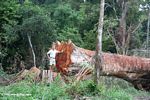This is the first part of a two-part series. Part II discusses in more detail the proposal’s possible impact on Bolivia’s forests.
On August 14, the Bolivian Vice President, Alvaro Garcia Linera, made a startling announcement: by 2025, Bolivia was going to make two striking developments – first, it would expand all cultivated land to 2.5 times its present area, and second, it would triple food production from 15 to 45 million tons.
This announcement has come as somewhat of a shock to most, particularly when considered in light of Bolivia’s strong stance on sustainable land use – Bolivia is famous for refusing to commercialize climate change, with President Evo Morales opposing even the marketing of carbon stocks through REDD+ programs.
 The projected outcomes of the new proposal on agricultural expansion in Bolivia. Graph by Mrinalini Erkenswick Watsa.
The projected outcomes of the new proposal on agricultural expansion in Bolivia. Graph by Mrinalini Erkenswick Watsa.
In an open letter published in November 2008, President Morales writes “Climate change has placed all humankind before a great choice: to continue in the ways of capitalism and death, or to start down the path of harmony with nature and respect for life.”
In light of these sentiments, Bolivia adopted a landmark policy in late 2012 called the Law of Mother Earth. According to a Center for International Forestry Research (CIFOR) paper by Robert Müller and colleagues, this law “absolutely prohibits the conversion of forest land-use into other uses in live zones suitable for forestry…It also orders [the reclassification of] land-use to prevent the expansion of the agricultural frontier.”
Müller’s detailed analyses of the law, however, reveal several subtle contradictions. For example, although much emphasis is put on the minimizing of the advance of the agricultural frontier, no specific mentions of banning expansion of agricultural land are obvious in the text of the Law. Further, another law (No. 337 on Support to Food Production and Forest Restoration) was also passed in early 2013, and has an implicit objective to promote the expansion of the agricultural frontier. Müller and colleagues thus warn of a disconnect between the lofty ideals of the Morales government and the physical means provided by the same to implement the Law of Mother Earth.
According to Global Forest Watch, Bolivia has more than 65 million hectares of thick tree cover, much of which remains relatively intact. These forests are home to many animals, including the giant otter (Pteronura brasiliensis; listed as Endangered by the IUCN), the spectacled bear (Tremarctos ornatus; Vulnerable), the Pacarana (Dinomys branickii; Vulnerable), and even an isolated population of Andean mountain cats (Leopardus jacobita; Endangered).

Bolivia still has large tracts of intact forest, but has lost a large proportion since 2000. Map courtesy of Global Forest Watch.

Cropland abuts forest in central Bolivia. Photo courtesy of Google Earth.
Pacaranas are large, slow-moving, nocturnal rodents that inhabit the forests of northern and central Bolivia. The species is listed as Vulnerable by the IUCN, and is the sole member of the Dinomyidae family. Photo by Benjamin Frable.
In light of this complex history, Bolivia is now facing a novel proposition: an agricultural expansion on an unprecedented scale that may displace valuable forest habitat.
The proposal in question is a joint effort between La Federación de Empresarios Privados de Santa Cruz (FEPSC), La Cámara de Industria, Comercio, Servicios y Turismo de Santa Cruz (CAINCO), La Cámara Agropecuaria del Oriente (CAO), and the Bolivian government, as represented by Vice President Alvaro Garcia Linera.
It outlines a plan to increase cultivated land from 5.22 million hectares (mha) to 13 mha by the year 2025. This expansion will then allow agricultural production to triple, from the current value of 15 million tons of food to a targeted value of 45 million tons. When this goal is attained, the intention is to consume approximately 24 million tons of food within the country, and export the remaining 21 million tons to increase foreign exchange reserves – a staggering increase from current consumption of 13 million tons internally, with an additional export of only 2 million tons.
The plan is inspired by the rather prominent stagnation of the Bolivian agricultural sector in comparison to other South American countries, with Chile and Brazil outstripping Bolivia by far.
According to Gary Antonio Rodríguez Álvarez, the General Manager of the Bolivian Institute of Foreign Trade (IBCE), only 11 percent of cultivable land in Bolivia (about 30 million hectares) is currently being used for agriculture. The Department of Santa Cruz supports over 70 percent of all food production, and although it has grown in area (a 1.1-mha increase in the last 12 years), Álvarez claims that this is minimal compared to its true potential.
In fact, in an IBCE report on this joint effort, Alvarez even takes inspiration from Albert Einstein, encouraging Bolivians to change the way do things if they want to see different results.

Productivity per worker in the agricultural sector from 1980 to 2012. Bolivia’s trajectory is the flat black line at the bottom of the graph. Graph by Gary Antonio Rodríguez Álvarez, MSc. Economista, the General Manager of the IBCE.
Citations:
- IBCE. 2014. Encuentro Agroindustrial Productivo. 22:14.
}}
Related articles
Scientists uncover five new species of ‘toupee’ monkeys in the Amazon

(09/02/2014) While saki monkeys may be characterized by floppy mops of hair that resemble the worst of human toupees, these acrobatic, tree-dwelling primates are essential for dispersing seeds. After long being neglected by both scientists and conservationists, a massive research effort by one intrepid researcher has revealed the full-scale of saki monkey diversity, uncovering five new species.
How do we save the world’s vanishing old-growth forests?

(08/26/2014) There’s nothing in the world like a primary forest, which has never been industrially logged or cleared by humans. They are often described as cathedral-like, due to pillar-like trees and carpet-like undergrowth. Yet, the world’s primary forests—also known as old-growth forests—are falling every year, and policy-makers are not doing enough to stop it.
NASA: Forest loss leaps in Bolivia, Mekong region
(08/08/2014) New satellite data from NASA suggests that deforestation is sharply increasing in Bolivia and Mekong countries during the second quarter of 2014.

(07/09/2014) The Amazon is the largest tropical forest on the planet, covering about 6.5 million square kilometers, although much has been lost in recent decades.Yet new research published in the Proceedings of the National Academy of Sciences (PNAS) finds that quite recently—just 500 years ago—a significant portion of the southern Amazon was not the tall-canopied forest it is today, but savannah.
Size matters: small animals abundant in fragmented forests, large animals not

(06/25/2014) Habitat fragmentation and hunting are both distinct critical issues facing forests today that require their own countermeasures. Yet, much research has chosen to conflate the two, potentially leading to ineffective ecosystem management. According to a new study, the interaction of both factors can contradict the effects of hunting and fragmentation alone, revealing a research and management gap that urgently needs to be filled.
NASA detects surge in deforestation in Malaysia, Bolivia during first quarter of 2014
(04/21/2014) Forest disturbance in Malaysia, Bolivia, Panama, and Ecuador surged during the first quarter of 2014, according to NASA data.
Ants plant rainforests, one seed at a time
(04/14/2014) Deforestation is destroying forests around the world, but its effects are especially obvious in the Amazon Basin. Due to cattle ranching, soybean farming, logging, and slash-and-burn agriculture, the rainforest is disappearing at a rapid pace. But a recent study published in the Journal of Ecology offers a unique solution to replanting the deforested landscapes: ants.
Emissions from rainforest logging average 16% of those from deforestation
(04/08/2014) Carbon emissions from selective logging operations in tropical rainforests are roughly a sixth of those from outright forest clearing, finds a new study that evaluated 13 forestry concessions in six countries. The study analyzed carbon losses from elements of logging operations, including timber extraction, collateral damage to surrounding vegetation, and logging infrastructure like roads and skid trails.
Controversial Amazon dams may have exacerbated biblical flooding

(03/16/2014) Environmentalists and scientists raised howls of protest when the Santo Antônio and Jirau Dams were proposed for the Western Amazon in Brazil, claiming among other issues that the dams would raise water levels on the Madeira River, potentially leading to catastrophic flooding. It turns out they may have been right: last week a federal Brazilian court ordered a new environmental impact study on the dams given suspicion that they have worsened recent flooding in Brazil and across the border in Bolivia.
Good news: Refuge for last blue-throated macaws doubles in size in Bolivia
(01/02/2014) A reserve that is home to the world’s largest population of the critically endangered blue-throated macaw (Ara glaucogularis) has been more than doubled in size, reports the American Bird Conservancy (ABC), a group that helped fund the expansion.


